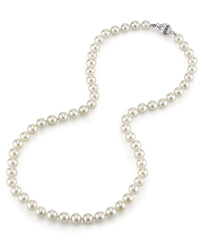
Japanese Akoya White Pearl Necklace, 6.5-7.0mm - AAA Quality
$1,540.00 Sale: $1,232.00


The dark and mysterious Tahitian pearl is cultured in the pinctada margaritifera black-lipped saltwater pearl oyster which can grow up to a foot in diameter at its largest.
Tahitian pearl lovers and collectors can also hunt for the polished Tahitian pearl shells, which display colorful iridescence and a unique beauty all their own.

Tahitian pearls, dark grey orbs of great beauty and compelling mystique. Formed in the large, black-lipped Pinctada Margaritifera oyster of the South Seas, as pearl lovers, we are drawn to Tahitian pearls. This is not least because Tahitian pearls overtly challenge the very idea of pearls - demure, elegant, white gems. Commonly referred to as “black pearls,” these pearls come in a range of alluring colors – light and dark grey, silver and the most coveted, black– with a host of secondary colors creating magnificent, sometimes even rainbow-like, overtones.
The interesting thing about Tahitian pearls is that they are not farmed in Tahiti. Instead, it is in the pearl farms in French Polynesia where we find the most luscious of these pearls. The very definition of glamour and sophistication, wearing Tahitian pearls is a subtle way of saying “look at me.”

The shell of the Pinctada Margaritifera oyster has long been coveted by the indigenous peoples of Polynesia for its iridescent mother-of-pearl. Traditionally, it was used as jewelled adornment. Silver grey carved discs of shell were worn as pendants and decorative embellishments on robes. But there is very little that is known about how these natural pearls were used by the people of Polynesia.
A fascinating anecdote shared by George Kunz in his “The Book of The Pearl” tells of Queen Pomare, monarch of Tahiti in the early 1800s, playing marbles with black pearls.
With the arrival of European sailors to the Polynesian shores, the shells started being harvested in large quantities for use in jewelry, as buttons and for inlay work in furniture, in the West. Black pearls, accidents of nature, also began to be used in fine jewelry. However, such was the demand for the Pinctada Margaritifera mother-of-pearl that by the 1850s, overharvesting had led to a sharp decline in the population of these oysters.

A century later, in the 1950s, due to depletion of stock, oyster fishing was no longer the primary economic activity in much of French Polynesia. Instead coconut plantations had become an important source of income for the islands.
But things started to change in the 1960s when French veterinarian Jean Marie Domard began studying pearl cultivation and with the help of Japanese pearl technicians, cultivated about 5000 Pinctada Margaritifera oysters. By 1964, the first pearl farm was established in French Polynesia by Hubert and Jacques Rosenthal, who belonged to Rosenthal jewelry family, known for their spectacular pearl jewels. This pearl farm became fully functional by 1966 ...